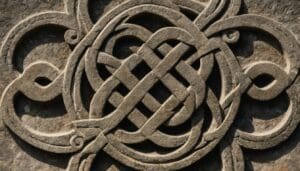Kom Ombo Temple: The Jewel of the Ptolemaic Dynasty
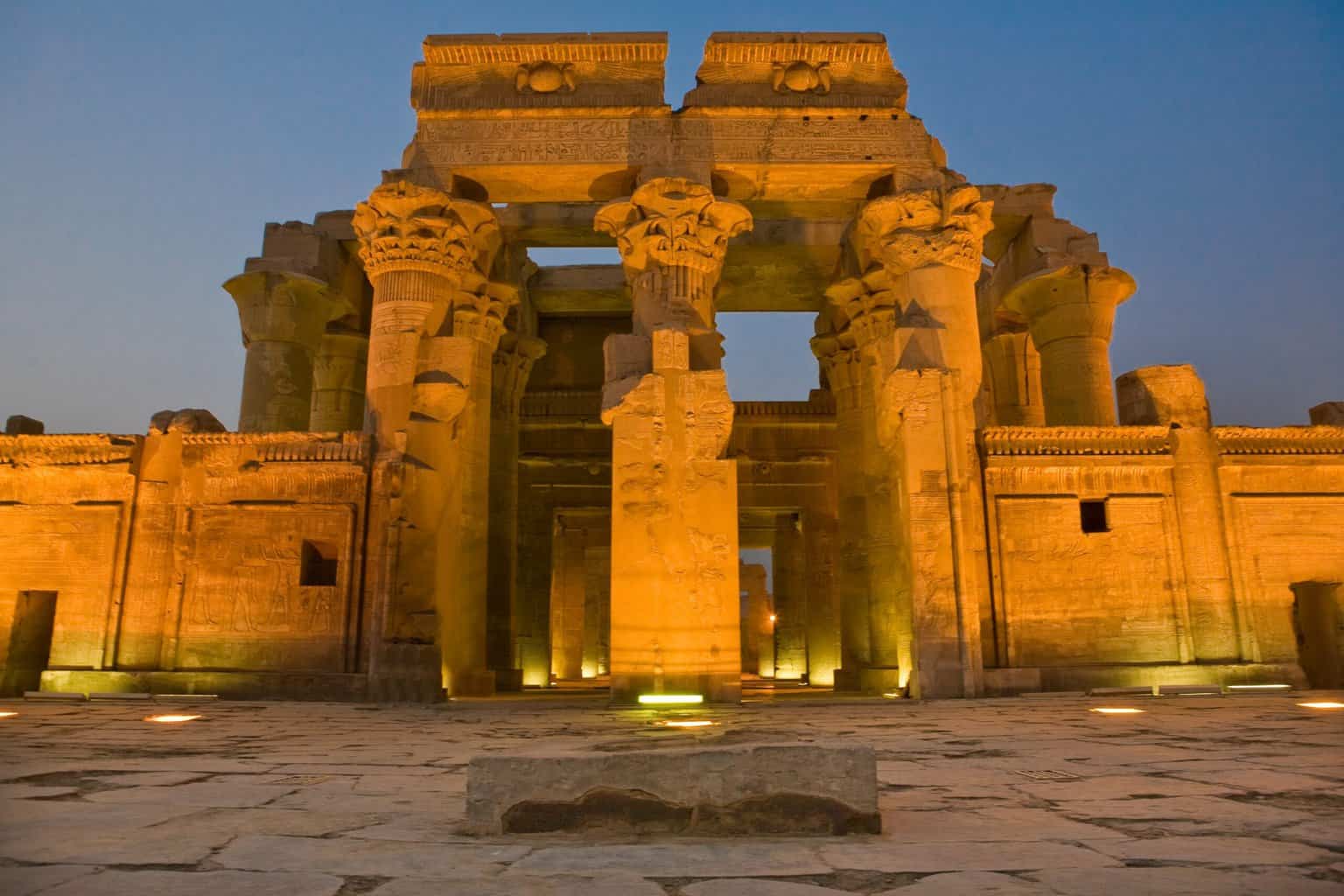
Updated On: November 08, 2023 by Ahmed Samir
Kom Ombo Temple is located in Aswan. It was one of the impressive constructions of the Ptolemaic dynasty, which ruled Egypt for three centuries, from 305 to 30 BC. After that, it fell at the hands of the Romans. Despite their extended rule of Egypt, they did not integrate with the Egyptian people but isolated themselves in Alexandria, which they took as their capital.
The rule of the Ptolemies of Egypt began after one of the followers of Alexander the Great, Ptolemy I Soter, declared that he was the pharaoh of Egypt. It was a solid Hellenistic state that extended from southern Syria in the east, Cyrene to the west, and from the south, it borders Nubia.
The Ptolemies ruled Egypt until the death of Cleopatra VII in 30 BC, and it was the wealthiest and most powerful kingdom for more than 300 years.
Kom Ombo City
Kom Ombo is a famous commercial centre in Egypt with many factories located 40 North of Aswan. The city has been given different names since the old days when it was called The City of Gold due to its close location to the gold mines. It was also named Anbu in Coptic, and the Greek name Ambos means the hills in the region.
The Reason for Building Kom Ombo Temple
The Temple of Kom Ombo was built by the Ptolemies to worship two gods, Sobek, the crocodile god, and Horus, the falcon god. It was built from 205 to 180 BC, during the reign of King Ptolemy V.
The crocodile symbolises the god Sobek who represents the world and the underworld. As for Horus, he symbolised the sun. The worship of the two gods continued from the New Kingdom until the Greco-Roman era.
Kom Ombo Temple Design
Kom Ombo temple was built mainly of limestone in a rectangle, with a plan and design similar to many temples built in the Roman era, such as the temple Philae.
The design includes a front yard and a pillared hall, followed by three inner aisles, where you will find seven rooms and additional smaller rooms used for many rituals.
Kom Ombo Temple from the Inside
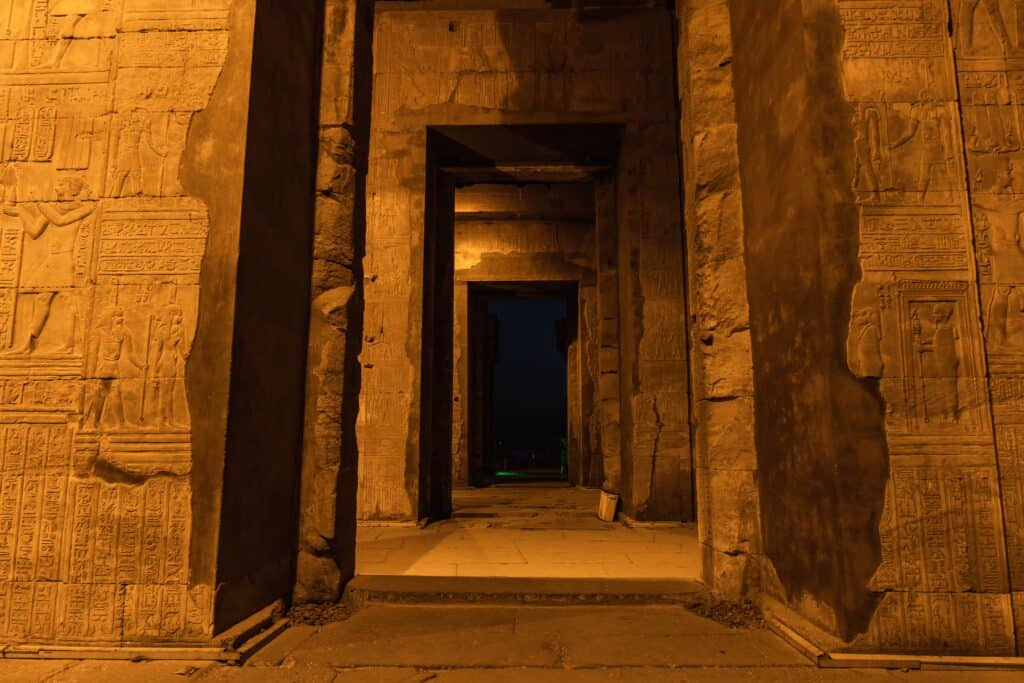
Kom Ombo Temple was divided into two parts, the left part for the god Horus and the other for Sobek, including a small water basin used for breeding crocodiles in the past. It is surrounded by a large wall and has two entrances, one to the Sobek section and another to the Horus section.
Inside the temple are drawings of the Nile goddess carrying papyrus and a lotus flower to indicate the unity of Egypt and engravings of servants carrying offerings to the gods. There are also drawings of Emperor Augustus, along with a long strip of hieroglyphs.
The Outer Gate of the Temple
The temple’s main gate was built of stone during the reign of king Ptolemy XII, and on the gates, there is a drawing of the King offering sacrifices to the god Sobek, represented in the form of a crocodile’s head holding a sceptre.
The Edifice
After entering the main gate, specifically on the eastern and western sides, you will see ruins of the sections built in Emperor Dommishan’s era. There are drawings of the king praying to the gods Horus and Sobek on the walls.
The Open Courtyard
The courtyard includes 16 columns in three directions; five are in the western and eastern directions, and six are in the southern area.
From ancient times till today, many columns have been destroyed, and the only parts left are the lower sections of most of the columns. When you move to the courtyard’s centre, you will find the location where sacrifices were given to the deity.
Many drawings show the sacrifices given to Sobek and Horus by Emperor Tiberius and, behind him, his wife, Hathor. Another drawing shows Emperor Tiberius wearing the red and white crowns of the god Horus as he holds a wand and the sign of life, the Ankh.
Anterior Column Hall
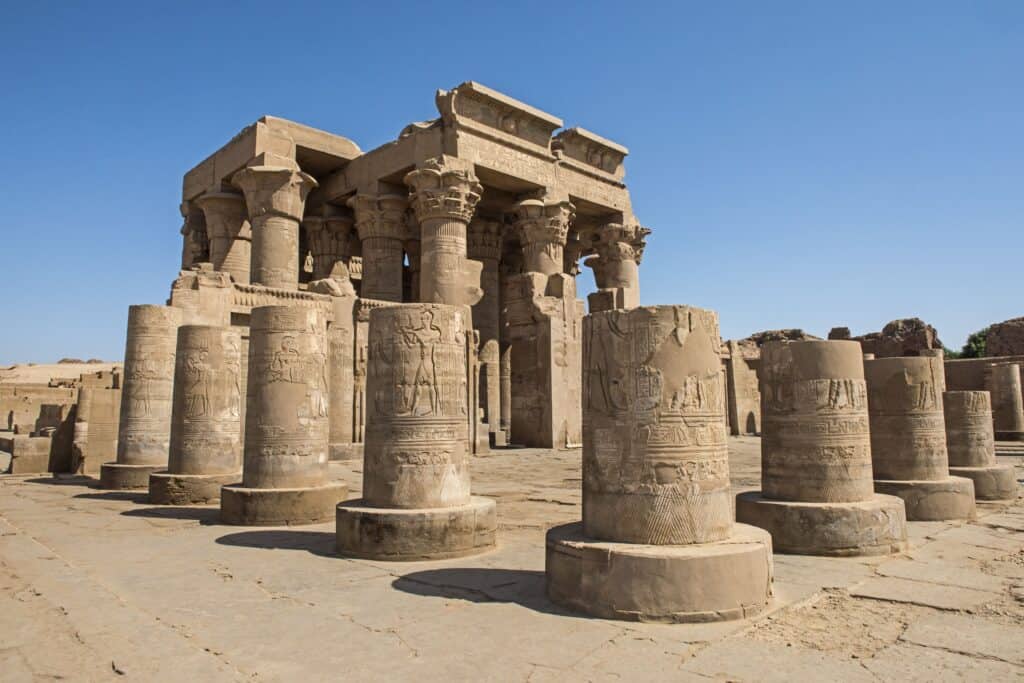
In the Anterior Column Hall, you will find about ten columns built in the era of King Ptolemy XII. Also, stone curtains are seen with carvings of the king in a kneeling position in front of the gods Thoth and Sobek.
On the walls are inscriptions of King Ptolemy VIII, wearing the crown of Lower Egypt and offering sacrifices to the gods.
The Inner Pillared Hall
The Inner Pillared Hall of Kom Ombo Temple contains ten columns in two rows in the form of a papyrus flower, and it was built in the era of King Ptolemy VIII.
At the top of the eastern door, you will see drawings of King Ptolemy VI with Queen Cleopatra II serving wine to the Sobek Trinity and the Horus Trinity.
The First Inner Hall
On the outer gate of the first inner hall, you will see pharaonic murals of King Ptolemy VI offering wine to Sobek and his wife, Hathor.
The Second Inner Hall
The second inner hall contains two rectangular chambers; when you enter, you will see many exquisite murals of King Ptolemy VI offering utensils to the god Horus and Sobek.
There are murals on the wall of the inner hall of King Ptolemy VI worshipping snakes, and another one where he is wearing a crown and holding a sceptre and the sign of the Ankh with his wife, Queen Cleopatra II.
The Third Inner Hall
Its design is the same as the second inner hall, with many inscriptions across the hall of King Ptolemy VI and drawings of Queen Cleopatra II offering the sign of justice, Maat, to the gods Horus, Sobek and Hathor.
The Mammisi
The Mammisi, or the birthplace, was built by King Ptolemy VIII. It contains four columns in one hall and two other halls for performing birth rituals.
Hathor’s Cabin
Hathor’s cabin is a one-floor room with a mud-brick wall in a rectangular shape. It contains a glass box with three crocodile mummies. The cabin’s façade has drawings of the god Hathor offering wine to Tascent Nefert.
Entry Ticket Prices
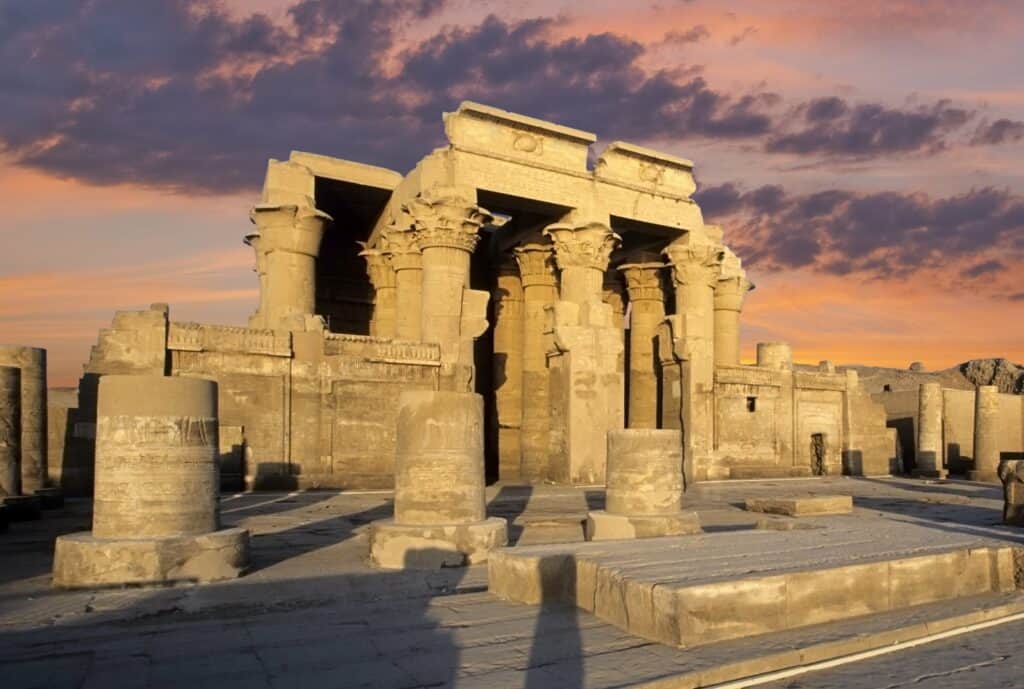
The entrance tickets aren’t expensive but affordable for everyone, whether they are Egyptians or foreigners. Ticket prices are divided into the following:
- Egyptians: 20 Egyptian pounds
- Egyptian Students: 5 Egyptian Pounds
- Foreigners: 140 Egyptian Pounds
- Foreigner Students: 70 Egyptian Pounds
Hotels Near Kom Ombo Temple
With all the attractions in Aswan to visit, including Kom Ombo Temple, you will need a hotel to stay in and rest so you can continue your journey in the beautiful city of Aswan. Here are some of the hotels located near Kom Ombo Temple.
- Tulip Aswan Hotel
- Pyramisa Isis Corniche Aswan
- Mövenpick Resort Aswan
- Sofitel Legend Old Cataract Aswan
At the end of the article, we highlighted one of the important attractions in Egypt and Aswan in particular. We hope we could convey a lot of information about this grand tower and its importance during the era of the Pharaohs and the Ptolemies.


